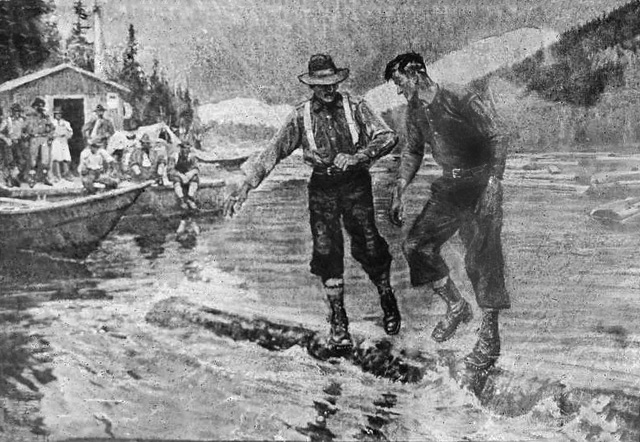Log Rolling
Log rolling or Logrolling began as a sport in the late 1800s during the great logging era. It originated in the lumberjack and log tradition in the north east of United States and Canada. It is also called Birling.
More than hundreds of logs were floating down the river, jammed, so men were hired to prevent the jams. They would work on the river, stepping on the floating logs as they worked from bank to bank. The loggers would challenge one another to see who would stay on the longest.
During summer, different companies of lumberjacks sponsored log rolling contestant, sending their best player.
The first unofficial Log Rolling Championship was in 1898 that took place in Omaha, Nebraska.
The sport involves logs in a river or any body of water. That contestant starts to “walk” or by rolling the log as the opponent tries to keep up. The goal of the game is to try to stay on the log while causing the opponent to lose their balance and fall to the river.
 Log Rolling
Log RollingThere are four different sizes of logs for the competitions, with different numbers and colors linked with it. The US has 5 log sizes For example, the US size of I Log is 15 inches in diameter and 12 feet long, II Log is 14 inches in diameter and 12 feet, III Log is 13 inches in diameter and 13 feet, IV Log is 12 inches in diameter and 13 feet and the V Log is 11 inches in diameter and 13 feet long.
In Canada, it wasn't established until the late 1960s where they promoted the sport officially in Canada. They have 4 log sizes with I Log 17 inches in diameter and 12/13 feet, II Log is 15 inches in diameter and 12/13 feet, III Log is 13 inches in diameter and 12/13 feet and IV Log is 12 inches and 12/13 feet.
Rules are simple – one can rock, stop, reverse the spin, intensify the spin of the leg, even extend a foot and kick water into the opponent’s face. Physical contact, crossing the log’s center line and spitting tobacco juice into opponent’s face isn’t allowed.
The roll ends when the person falls into the river. If both of the contestants fall to the water, the loser is the contestant who first fell into the river. The match continues until the best of three or best of five rolls
Similar Sports
- Lumberjack — competitions involving many different events, including log rolling, chopping, timed hot (power) saw and bucksaw cutting, and pole climbing.
- Log Sawing — involves cutting across entire logs of wood using saws.
